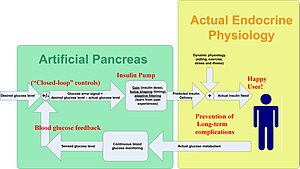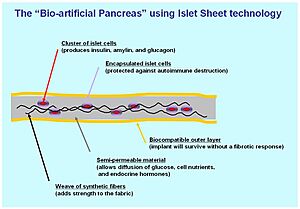Automated insulin delivery system facts for kids
Automated insulin delivery systems are smart devices that help people with diabetes manage their blood glucose levels. They work by automatically giving the right amount of insulin when needed. These systems are often called an artificial pancreas.
Your real pancreas has special cells that make hormones like insulin and glucagon. These hormones keep your blood sugar balanced. For people with diabetes, their body can't make enough insulin. So, an artificial pancreas helps by giving insulin to keep blood sugar levels healthy. This is super important for your brain, liver, and kidneys to work well.
Contents
What are Automated Insulin Delivery Systems?
How They Started
The very first automated insulin delivery system was called the Biostator. It was a big step towards today's smart systems.
Types of AID Systems
Today's automated insulin delivery (AID) systems come in a few types, depending on how much they do automatically:
Predictive Low Glucose Suspend (PLGS)
These systems are pretty clever. They use a continuous glucose monitor (CGM) to guess if your blood sugar might go too low soon. If it predicts a low, the system can stop or slow down insulin delivery. This helps prevent your blood sugar from dropping too much.
Hybrid Closed Loop (HCL)
Hybrid closed loop systems do even more. They can adjust your background insulin (called basal insulin) up or down based on your CGM readings. This helps keep your blood sugar more stable, avoiding big highs or lows. However, you still need to tell the system when you eat and give yourself insulin for meals.
Fully Closed Loop (FCL)
Fully closed loop systems are the most automated. They adjust insulin all by themselves, without you needing to tell them about meals or give extra insulin shots. They aim to handle everything automatically.
Parts of an AID System
An automated insulin delivery system needs three main parts to work:
Continuous Glucose Monitor (CGM)
A continuous glucose monitor (CGM) is a small sensor you wear on your skin. It checks your glucose levels every few minutes. It doesn't check your blood directly, but rather the fluid just under your skin. This gives the system a constant stream of information about your blood sugar trends. Knowing where your blood sugar is going helps the system make smart decisions.
Insulin pump
An insulin pump is a small device that delivers insulin into your body through a tiny tube under your skin. The pump can also hold the "brain" (algorithm) of the AID system. Or, it can connect wirelessly to a smartphone that runs the algorithm. This allows the pump to get commands and adjust insulin delivery.
Algorithm
The algorithm is like the "brain" of the AID system. It's a computer program that takes the glucose data from the CGM. Then, it uses your personal settings (like how sensitive you are to insulin) to figure out how much insulin you need. It tells the pump to give more or less insulin to keep your blood sugar in a healthy range. Some systems let you adjust your target blood sugar level.
Systems You Can Get Now
Many different AID systems are available around the world. Here are some examples:
Commercial Systems
MiniMed 670G and 780G
The Medtronic MiniMed 670G was one of the first hybrid closed loop systems approved. It automatically adjusts your background insulin. It uses a CGM, an insulin pump, and a glucose meter. The system has an "Auto Mode" that adjusts insulin every five minutes based on CGM readings. The newer 780G system has even more advanced features.
Tandem Diabetes Care t:Slim X2 with Control-IQ
This system was approved in 2019. It's an "alternate controller enabled" (ACE) insulin pump. This means it can connect with different CGMs and AID systems. Many people use it with the Dexcom G6 CGM. This CGM doesn't need finger-prick tests for calibration.
Omnipod 5
The Omnipod 5 is a tubeless insulin pump system. It's also a hybrid closed loop system that connects wirelessly to a CGM. It's designed to be easy to use and discreet.
iLet Bionic Pancreas
Approved in May 2023, the iLet Bionic Pancreas system is for people with Type 1 diabetes aged six and older. This system is unique because it can deliver both insulin and glucagon. Glucagon is a hormone that raises blood sugar, which can be helpful if levels drop too low. The device is about the size of a smartphone. Studies have shown it helps control glucose better.
DIY Options
Some people with diabetes have created their own non-commercial AID systems. These "DIY" options use open-source code. Examples include OpenAPS, Loop, and AndroidAPS. These are not approved by health authorities but show what's possible.
Systems Being Developed
Scientists and companies are always working on new and better AID systems.
Luna Diabetes
This team is working on an AID system for people who prefer to use insulin pens instead of pumps. They call it "Episodic AID." The product is named Luna.
Inreda AP
The Inreda AP is a closed-loop system being developed in the Netherlands. It can deliver both insulin and glucagon. The person who started this project, Robin Koops, even tested it on himself first! It has received approval in Europe and is being tested in larger studies.
How AID Systems Work (Approaches)
Medical Equipment Approach
This approach combines existing medical devices. It uses a continuous glucose monitor, an insulin pump, and a computer program (algorithm). These parts work together to act like a pancreas. The development of CGMs has really helped this technology grow.
Closed-Loop Systems
A closed-loop system is fully automated. It doesn't need you to tell it what to do after it gets readings from the CGM. The system automatically figures out and delivers the right amount of insulin. This is what makes up the "artificial pancreas" device.
Current Studies
Many studies are happening to test new artificial pancreas systems. These studies let people use the devices at home while researchers watch how well they work and if they are safe. For example, one study is testing a system called inControl with a smartphone app. Another study is looking at a system for children and teens.
Physiological Approach
This approach tries to create a "bio-artificial" pancreas. Companies like Defymed and ViaCyte are working on this. They create devices that hold special cells, often from stem cells. These cells can make insulin and glucagon, just like your own pancreas cells.
The devices are designed to be implanted in the body. They have a special membrane that protects the cells inside from your body's immune system. This means you might not need medicines to stop your body from rejecting the implant. The goal is for these implanted cells to work for years, releasing hormones as needed.
Efforts Around the World
Many groups are working to make AID systems better and more available.
In the United States, JDRF (which used to be called the Juvenile Diabetes Research Foundation) started a big effort in 2006. Their goal was to speed up the development and approval of CGM and artificial pancreas technology.
Also, people with diabetes and their supporters have started their own groups. They work to create and share fully automated artificial pancreas systems.
In April 2024, the National Health Service (NHS) in England announced a plan. Over the next five years, they will offer hybrid closed loop systems to people with Type 1 diabetes.
See Also
- Artificial pancreas (disambiguation)
Images for kids





